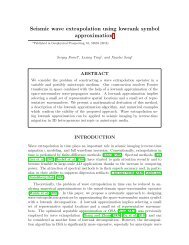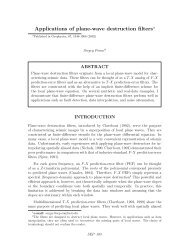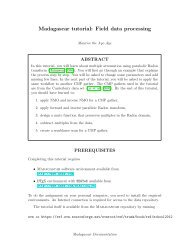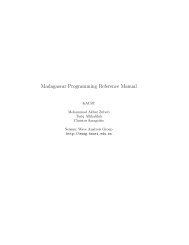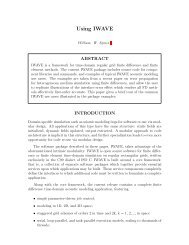pdf - Madagascar
pdf - Madagascar
pdf - Madagascar
Create successful ePaper yourself
Turn your PDF publications into a flip-book with our unique Google optimized e-Paper software.
Homework 5<br />
Thomas Bayes<br />
This homework has two parts.<br />
ABSTRACT<br />
1. Theoretical questions related to covariance estimation.<br />
2. Missing data interpolation for ocean floor topography using covariance estimation.<br />
PREREQUISITES<br />
Completing the computational part of this homework assignment requires<br />
• <strong>Madagascar</strong> software environment available from<br />
http://www.ahay.org/<br />
• L A TEX environment with SEGTEX available from<br />
http://www.ahay.org/wiki/SEGTeX<br />
To do the assignment on your personal computer, you need to install the required<br />
environments. Please ask for help if you don’t know where to start.<br />
The homework code is available from the <strong>Madagascar</strong> repository by running<br />
svn co http://svn.code.sf.net/p/rsf/code/trunk/book/geo391/hw5<br />
THEORY<br />
1. The following equality for the posterior model covariance was given in lecture<br />
notes without a proof:<br />
Ĉ m = ( F T C −1<br />
n<br />
Prove it.<br />
)<br />
F + C −1 −1<br />
m = Cm − C m F ( ) T F C m F T −1<br />
+ C n F Cm . (1)
2<br />
2. Suppose that we use the gradient operator for data interpolation:<br />
min |∇m| 2 . (2)<br />
This approach roughly corresponds to minimizing the surface area and represents<br />
the behavior of a soap film or a thin rubber sheet.<br />
The corresponding inverse model covariance operator is the negative Laplacian<br />
C −1<br />
m = ∇ T ∇ = −∇ 2 . The corresponding covariance operator corresponds to<br />
the Green’s function G(x) that solves<br />
In 2-D, the Green’s function has the form<br />
with some constant A.<br />
−∇ 2 G = δ(x − x 0 ) . (3)<br />
G(x) = A − ln |x − x 0|<br />
2π<br />
To derive equation (4), we can introduce polar coordinates around x 0 with the<br />
radius r = |x−x 0 | and note that the Laplacian operator for a radially-symmetric<br />
function φ(r) in polar coordinates takes the form<br />
Away from the point x 0 , solving<br />
∇ 2 φ = 1 r<br />
1<br />
r<br />
d<br />
dr<br />
d<br />
dr<br />
(<br />
r dφ )<br />
dr<br />
(4)<br />
(5)<br />
(<br />
r dG )<br />
= 0 (6)<br />
dr<br />
leads to G(r) = A + B ln r. To find the constant B, we can integrate ∇ 2 G<br />
over a circle with some small radius ɛ around the origin and apply the Green’s<br />
theorem<br />
∫∫<br />
−1 =<br />
∮<br />
∇ 2 Gdx dy =<br />
∇G · ⃗ds =<br />
∫ 2π<br />
0<br />
∂G<br />
∂r<br />
∣ ɛ dθ = 2π B . (7)<br />
r=ɛ<br />
Derive the model covariance function G(x) which corresponds to replacing equation<br />
(2) with equation<br />
min ∣ ∣ ∇ 2 m ∣ ∣ 2 (8)<br />
and approximates the behavior of a thin elastic plate.
3<br />
Figure 1: (a) Water depth measurements from one day of SeaBeam acquisition. (b)<br />
Mask for locations of known data.<br />
MISSING OCEAN-FLOOR DATA INTERPOLATION<br />
SeaBeam is an apparatus for measuring water depth both directly under a boat and<br />
somewhat off to the sides of the boat’s track. In this part of the assignment, we will<br />
use a benchmark dataset from Claerbout (2008): SeaBeam data from a single day of<br />
acquisition. The original data are shown in Figure 1a.<br />
Program interpolate.c implements two alternative methods: regularized inversion<br />
using convolution with a multi-dimensional filter and preconditioning, which uses<br />
the inverse operation (recursive deconvolution or polynomial division on a helix) for<br />
model reparameterization.<br />
Our first attempt is to use the Laplacian-factor filter from the previous homework.<br />
The results from the two methods are shown in Figure 2. They are not very successful<br />
in hiding the “acquisition footprint”.<br />
Next, we will try to estimate the model covariance from the available data. The<br />
covariance can be estimated using two alternative methods: the fast Fourier transform<br />
(FFT) method (Marcotte, 1996) and the prediction-error filter (PEF) method<br />
(Claerbout and Brown, 1999). Random realizations of model patterns from the two<br />
methods and the corresponding 2-D Fourier spectra are shown in Figures 3 and 4.<br />
Our new attempt to interpolate missing data using the helical prediction-error<br />
filter is shown in Figure 5.
4<br />
Figure 2: Left: missing data interpolation using regularization by convolution with a<br />
Laplacian factor. Right: missing data interpolation using model reparameterization<br />
by deconvolution (polynomial division) with a Laplacian factor.<br />
Figure 3: Left: data pattern generated using FFT method for covariance estimation.<br />
Right: its Fourier spectrum.
5<br />
Figure 4: Left: data pattern generated using PEF method for inverse covariance<br />
estimation. Right: its Fourier spectrum.<br />
Figure 5: Left: missing data interpolation using regularization by convolution with<br />
a prediction-error filter. Right: missing data interpolation using model reparameterization<br />
by deconvolution (polynomial division) with a prediction-error filter.
6<br />
seabeam/interpolate.c<br />
1 /∗ Multi−dimensional missing data i n t e r p o l a t i o n . ∗/<br />
2<br />
3 #include <br />
4<br />
5 int main ( int argc , char∗ argv [ ] )<br />
6 {<br />
7 int na , ia , n i t e r , n , i ;<br />
8 float a0 , ∗mm, ∗ zero ;<br />
9 bool prec , ∗known ;<br />
10 char ∗ l a g f i l e ;<br />
11 s f f i l t e r aa ;<br />
12 s f f i l e in , out , f i l t , lag , mask ;<br />
13<br />
14 s f i n i t ( argc , argv ) ;<br />
15 in = s f i n p u t ( ” in ” ) ;<br />
16 f i l t = s f i n p u t ( ” f i l t ” ) ;<br />
17 /∗ f i l t e r f o r i n v e r s e model covariance ∗/<br />
18 out = s f o u t p u t ( ” out ” ) ;<br />
19<br />
20 n = s f f i l e s i z e ( in ) ;<br />
21<br />
22 i f ( ! s f g e t b o o l ( ” prec ”,& prec ) ) prec=true ;<br />
23 /∗ I f y , use p r e c o n d i t i o n i n g ∗/<br />
24 i f ( ! s f g e t i n t ( ” n i t e r ”,& n i t e r ) ) n i t e r =100;<br />
25 /∗ Number o f i t e r a t i o n s ∗/<br />
26<br />
27 i f ( ! s f h i s t i n t ( f i l t , ”n1”,&na ) ) s f e r r o r ( ”No n1=” ) ;<br />
28 aa = s f a l l o c a t e h e l i x ( na ) ;<br />
29<br />
30 i f ( ! s f h i s t f l o a t ( f i l t , ”a0”,&a0 ) ) a0 =1.;<br />
31<br />
32 /∗ Get f i l t e r l a g s ∗/<br />
33 i f (NULL == ( l a g f i l e = s f h i s t s t r i n g ( f i l t , ” l a g ” ) ) ) {<br />
34 for ( i a =0; i a < na ; i a++) {<br />
35 aa−>l a g [ i a ]= i a +1;<br />
36 }<br />
37 } else {<br />
38 l a g = s f i n p u t ( l a g f i l e ) ;<br />
39 s f i n t r e a d ( aa−>lag , na , l a g ) ;<br />
40 s f f i l e c l o s e ( l a g ) ;<br />
41 }<br />
42<br />
43 /∗ Get f i l t e r v a l u e s ∗/
7<br />
44 s f f l o a t r e a d ( aa−>f l t , na , f i l t ) ;<br />
45 s f f i l e c l o s e ( f i l t ) ;<br />
46<br />
47 /∗ Normalize ∗/<br />
48 for ( i a =0; i a < na ; i a++) {<br />
49 aa−>f l t [ i a ] /= a0 ;<br />
50 }<br />
51<br />
52 mm = s f f l o a t a l l o c (n ) ;<br />
53 zero = s f f l o a t a l l o c (n ) ;<br />
54 known = s f b o o l a l l o c (n ) ;<br />
55<br />
56 /∗ s p e c i f y known l o c a t i o n s ∗/<br />
57 mask = s f i n p u t ( ”mask” ) ;<br />
58 s f f l o a t r e a d (mm, n , mask ) ;<br />
59 s f f i l e c l o s e ( mask ) ;<br />
60<br />
61 for ( i =0; i < n ; i++) {<br />
62 known [ i ] = ( bool ) (mm[ i ] != 0 . 0 f ) ;<br />
63 zero [ i ] = 0 . 0 f ;<br />
64 }<br />
65<br />
66 /∗ Read input data ∗/<br />
67 s f f l o a t r e a d (mm, n , in ) ;<br />
68<br />
69 i f ( prec ) {<br />
70 s f m a s k i n i t ( known ) ;<br />
71 s f p o l y d i v i n i t (n , aa ) ;<br />
72 s f s o l v e r p r e c ( sf mask lop , s f c g s t e p , s f p o l y d i v l o p ,<br />
73 n , n , n , mm, mm, n i t e r , 0 . , ”end” ) ;<br />
74 } else {<br />
75 s f h e l i c o n i n i t ( aa ) ;<br />
76 s f s o l v e r ( s f h e l i c o n l o p , s f c g s t e p , n , n , mm, zero ,<br />
77 n i t e r , ”known” , known , ”x0” , mm, ”end” ) ;<br />
78 }<br />
79<br />
80 s f f l o a t w r i t e (mm, n , out ) ;<br />
81<br />
82 e x i t ( 0 ) ;<br />
83 }
8<br />
1 from r s f . p r o j import ∗<br />
seabeam/SConstruct<br />
2<br />
3 # Download data<br />
4 Fetch ( ’ apr18 . h ’ , ’ seab ’ )<br />
5 Flow ( ’ data ’ , ’ apr18 . h ’ , ’ dd form=n a t i v e ’ )<br />
6<br />
7 def grey ( t i t l e ) :<br />
8 return ’ ’ ’<br />
9 grey p c l i p =100 l a b e l s z =10 t i t l e s z =12<br />
10 transp=n y r e v e r s e=n<br />
11 l a b e l 1=l o n g i t u d e l a b e l 2=l a t i t u d e t i t l e =”%s ”<br />
12 ’ ’ ’ % t i t l e<br />
13<br />
14 def sgrey ( t i t l e ) :<br />
15 return ’ ’ ’<br />
16 grey l a b e l s z =10 t i t l e s z =12 a l l p o s=y<br />
17 transp=n y r e v e r s e=n t i t l e =”%s ”<br />
18 l a b e l 1 =1/ l o n g i t u d e l a b e l 2 =1/ l a t i t u d e<br />
19 ’ ’ ’ % t i t l e<br />
20<br />
21 # Bin to r e g u l a r g r i d<br />
22 Flow ( ’ bin ’ , ’ data ’ ,<br />
23 ’ ’ ’<br />
24 window n1=1 f1=2 | math output =’(2978− input )/387 ’ |<br />
25 bin head=$SOURCE n i t e r =150 nx=160 ny=160 xkey=0 ykey=1<br />
26 ’ ’ ’ )<br />
27<br />
28 # Mask f o r known data<br />
29 Flow ( ’msk ’ , ’ bin ’ ,<br />
30 ’ ’ ’<br />
31 math output=”abs ( input )” |<br />
32 mask min=0.001 | dd type=f l o a t<br />
33 ’ ’ ’ )<br />
34<br />
35 Plot ( ’ bin ’ , grey ( ’ Binned ’ ) )<br />
36 Plot ( ’msk ’ , grey ( ’Mask ’ ) + ’ a l l p o s=y ’ )<br />
37<br />
38 Result ( ’ data ’ , ’ bin msk ’ , ’ SideBySideAniso ’ )<br />
39<br />
40 # Laplacian f a c t o r i z a t i o n<br />
41<br />
42 Flow ( ’ lag0 . asc ’ , None ,<br />
43 ’ ’ ’
9<br />
44 echo 1 160 n1=2 n=160 ,160<br />
45 data format=a s c i i i n t in=$TARGET<br />
46 ’ ’ ’ )<br />
47 Flow ( ’ lag0 ’ , ’ lag0 . asc ’ , ’ dd form=n a t i v e ’ )<br />
48<br />
49 Flow ( ’ f l t 0 . asc ’ , ’ lag0 ’ ,<br />
50 ’ ’ ’<br />
51 echo −1 −1 a0=2 n1=2 l a g=$SOURCE<br />
52 data format=a s c i i f l o a t in=$TARGET<br />
53 ’ ’ ’ , s t d i n =0)<br />
54 Flow ( ’ f l t 0 ’ , ’ f l t 0 . asc ’ , ’ dd form=n a t i v e ’ )<br />
55<br />
56 Flow ( ’ l a p f l t l a p l a g ’ , ’ f l t 0 ’ ,<br />
57 ’ wilson eps=1e−3 lagout=${TARGETS[ 1 ] } ’ )<br />
58<br />
59 # Missing data i n t e r p o l a t i o n with Laplacian<br />
60<br />
61 n i t e r =100<br />
62<br />
63 program = Program ( ’ i n t e r p o l a t e . c ’ )<br />
64<br />
65 for prec in ( 0 , 1 ) :<br />
66 i n t e r p=’ l i n t e r p%d ’ % prec<br />
67 Flow ( interp , ’ bin msk l a p f l t %s ’ % program [ 0 ] ,<br />
68 ’ ’ ’<br />
69 . / ${SOURCES[ 3 ] } prec=%d n i t e r=%d<br />
70 mask=${SOURCES[ 1 ] } f i l t =${SOURCES[ 2 ] }<br />
71 ’ ’ ’ % ( prec , n i t e r ) )<br />
72 Plot ( interp , grey ( ’%s p r e c o n d i t i o n i n g ’ %<br />
73 ( ’ Without ’ , ’ With ’ ) [ prec ] ) )<br />
74 Result ( ’ lseabeam ’ , ’ l i n t e r p 0 l i n t e r p 1 ’ , ’ SideBySideAniso ’ )<br />
75<br />
76 # Random r e a l i z a t i o n o f white noise<br />
77 seed = 102012 # CHANGE ME! ! !<br />
78<br />
79 Flow ( ’ white ’ , ’ bin ’ ,<br />
80 ’ ’ ’<br />
81 noise rep=y seed=%d var =0.02<br />
82 ’ ’ ’ % seed )<br />
83<br />
84 # Covariance e s t i m a t i o n by FFT<br />
85<br />
86 import r s f . r e c i p e s . s p a t i a l s t a t s as s t a t s<br />
87<br />
88 par = d i c t ( val=’ bin ’ , ind=’msk ’ ,
10<br />
89 nx=160,ny=160,nz=1,<br />
90 dx =0.00337373 ,<br />
91 dy =0.00338847 ,<br />
92 dz=1)<br />
93<br />
94 r u l e s = {}<br />
95 s t a t s . c o v a r i a n c e ( par , r u l e s )<br />
96 for case in r u l e s . keys ( ) :<br />
97 Flow ( case , r u l e s [ case ] [ 0 ] , r u l e s [ case ] [ 1 ] )<br />
98<br />
99 Flow ( ’ fcov ’ , ’ bin cov ’ ,<br />
100 ’ ’ ’<br />
101 window n1=160 n2=160 |<br />
102 f f t 1 | f f t 3 a x i s=2 |<br />
103 math output=”abs ( input )”<br />
104 ’ ’ ’ )<br />
105 Flow ( ’ rand2 ’ , ’ white fcov ’ ,<br />
106 ’ ’ ’<br />
107 f f t 1 | f f t 3 a x i s=2 |<br />
108 math f c o v=${SOURCES[ 1 ] } output=”input ∗ f c o v ” |<br />
109 f f t 3 a x i s=2 inv=y | f f t 1 inv=y<br />
110 ’ ’ ’ )<br />
111 Plot ( ’ rand2 ’ , grey ( ’FFT Pattern ’ ) )<br />
112<br />
113 Flow ( ’ frand2 ’ , ’ rand2 ’ , ’ s p e c t r a 2 ’ )<br />
114 Plot ( ’ frand2 ’ , sgrey ( ’FFT Spectrum ’ ) )<br />
115<br />
116 Result ( ’ rand2 ’ , ’ rand2 frand2 ’ , ’ SideBySideAniso ’ )<br />
117<br />
118 # Covariance e s t i m a t i o n by PEF<br />
119<br />
120 # Estimate PEF<br />
121 Flow ( ’ pef l a g ’ , ’ bin msk ’ ,<br />
122 ’ ’ ’<br />
123 p e f maskin=${SOURCES[ 1 ] } l a g=${TARGETS[ 1 ] }<br />
124 a=5,3 n i t e r =50<br />
125 ’ ’ ’ )<br />
126<br />
127 Flow ( ’ rand ’ , ’ white pef ’ ,<br />
128 ’ h e l i c o n f i l t =${SOURCES[ 1 ] } div=y ’ )<br />
129 Plot ( ’ rand ’ , grey ( ’REF Pattern ’ ) )<br />
130<br />
131 Flow ( ’ frand ’ , ’ rand ’ , ’ s p e c t r a 2 ’ )<br />
132 Plot ( ’ frand ’ , sgrey ( ’PEF Spectrum ’ ) )<br />
133
11<br />
134 Result ( ’ rand ’ , ’ rand frand ’ , ’ SideBySideAniso ’ )<br />
135<br />
136 # Missing data i n t e r p o l a t i o n with PEF<br />
137<br />
138 n i t e r =20 # CHANGE ME! ! !<br />
139<br />
140 for prec in ( 0 , 1 ) :<br />
141 i n t e r p=’ i n t e r p%d ’ % prec<br />
142 Flow ( interp , ’ bin msk pef %s ’ % program [ 0 ] ,<br />
143 ’ ’ ’<br />
144 . / ${SOURCES[ 3 ] } prec=%d n i t e r=%d<br />
145 mask=${SOURCES[ 1 ] } f i l t =${SOURCES[ 2 ] }<br />
146 ’ ’ ’ % ( prec , n i t e r ) )<br />
147 Plot ( interp , grey ( ’%s p r e c o n d i t i o n i n g ’ %<br />
148 ( ’ Without ’ , ’ With ’ ) [ prec ] ) )<br />
149 Result ( ’ seabeam ’ , ’ i n t e r p 0 i n t e r p 1 ’ , ’ SideBySideAniso ’ )<br />
150<br />
151 End ( )<br />
Your task:<br />
1. Change directory to hw5/seabeam<br />
2. Run<br />
scons view<br />
to reproduce the figures on your screen.<br />
3. Modify the SConstruct file to implement the following tasks:<br />
(a) Find the number of iterations required for both methods shown in Figure 5<br />
to achieve similar results.<br />
(b) To provide a more quantitative comparison, modify the interpolate.c<br />
program to output a measure of convergence (such as the least-squares<br />
misfit) as a function of the number of iterations 1 . Generate figures comparing<br />
convergence with and without preconditioning.<br />
4. A method for generating multiple realizations of missing data interpolation is:<br />
(a) Start with a random realization m 0 such as the one shown in 4 or 3.<br />
(b) Instead of estimating m such that K m = d, estimate x such that<br />
K x = d − K m 0 .<br />
1 You can study the interfaces to the sf solver and sf solver prec programs. See https:<br />
//sourceforge.net/p/rsf/code/HEAD/tree/trunk/api/c/bigsolver.c
12<br />
(c) The estimate for m is then ̂m = ̂x + m 0 .<br />
Implement several realizations of missing data interpolation using several realizations<br />
of m 0 . You can do it by modifying either SConstruct or interpolate.c.<br />
5. Include your results in the paper.<br />
6. EXTRA CREDIT for implementing missing data interpolation using the FFT<br />
method for model covariance.<br />
COMPLETING THE ASSIGNMENT<br />
1. Change directory to hw5.<br />
2. Edit the file paper.tex in your favorite editor and change the first line to have<br />
your name instead of Bayes’s.<br />
3. Run<br />
sftour scons lock<br />
to update all figures.<br />
4. Run<br />
sftour scons -c<br />
to remove intermediate files.<br />
5. Run<br />
scons <strong>pdf</strong><br />
to create the final document.<br />
6. Submit your result (file paper.<strong>pdf</strong>) on paper or by e-mail.<br />
REFERENCES<br />
Claerbout, J., 2008, Image estimation by example: Environmental soundings image<br />
enhancement: Stanford Exploration Project.<br />
Claerbout, J., and M. Brown, 1999, Two-dimensional textures and prediction-error<br />
filters: 61st Mtg., Eur. Assn. Geosci. Eng., Session:1009.<br />
Marcotte, D., 1996, Fast variogram computation with FFT: Computers and Geosciences,<br />
22, 11751186.




